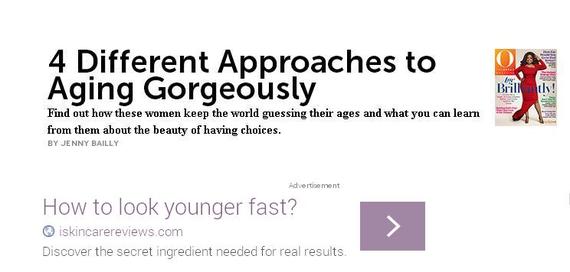Imagine that you're reading an article on aging gracefully, and as you approach the end of the piece, an ad "to look younger fast" catches your eye:
How would you feel: indifferent, insecure, angry or sad? What kinds of thoughts might be going through your mind? What would you do? Would you ignore the ad or journey down the rabbit hole of "self-improvement" propaganda?
The method behind the madness of digital marketing, and its effect on our psyche, is murky at best. But the extent to which companies will go to learn about who we are and what we might desire is expanding drastically. As we browse the Web, we feed the beast of personalized marketing. Our demographic data (e.g., age, sex), purchase history, and location inform marketers about how to target particular ads for display on our screen. Some websites curate personalized article recommendations based on our recent reading selections; others stream a list of currently-popular pieces.
The cumulative effect of this phenomenon can be dizzying, confusing, and potentially harmful. For example, a recent HuffPost blog of mine on getting summer ready was accompanied not just by sponsored product ads (like "your guilt-free suntan" and "take away hunger and increase your energy -- all while you lose weight"), but also by listings of articles including drastic weight loss stories and top 10 lists of exercises to do if you want a flat stomach. The juxtaposition between my article (intended to help readers resist the seasonal frenzy of media messages about dieting and exercise in favor of enhancing self-esteem as the foundation of any summer health agenda) and the page content running alongside it was stark.
While it's possible to stop marketers from snooping by opting out of online tracking or limiting advertisers' access to our search history, this is an unlikely long-term solution. We use many different online devices and cannot entirely close our eyes to magazines and billboards. Even if we could, technological advances encourage advertisers to consistently stake claims to new terrain (for example, thermostats!). Plus, advertising has long been a mechanism for media outlets to bankroll their operations. And from the marketers' perspectives, if people are happy just the way they are, no one makes money.
If we cannot control the data collection or the automatically-generated ads and reading lists, what can we do? Perhaps we can exercise more choice in our responses to the barrage of messages in the following ways:
• Reconcile opposites. Sometimes, the emotional puzzle created by an ad or article is worth puzzling through. If a message impacts us because it reflects a goal or a wish, it likely evokes a mixed reaction; it is both a reminder of a positive desired outcome and a negative evaluation of our present status. For example, if you are considering a return to routine exercise and read up on different workout options, you might notice an influx of ads for gyms and specialized fitness studios. These ads do tap into a goal but may make you feel defeated if you have neither the time nor money for organized exercise. In this case, the work might be to discard any part of the message that need not apply (e.g., joining a gym is the only way to exercise regularly) and embrace the aspects that might be helpful in sustaining motivation, brainstorming, and goal-setting (like creating an exercise partnership with a friend or developing an at-home schedule/routine). Ultimately, the goals should be for and about the individual and his or her values, not the product or narrative being sold.
• Challenge the notion that seeing is believing. The greatest risk to our mental health as a result of marketing is to believe that the advertisers' messages speak truth about us. This can be particularly hard to hold in mind if the messages with which we are confronted activate a pre-existing, negative set of thoughts or inspire acting on an unhealthy impulse. Imagine, for example, that you struggle with poor body image and often contemplate dieting unnecessarily. You might then automatically interpret ads about a drastic weight loss method as confirmation of your perceived need to lose weight. If you chose not to take this or other "personalized" ads so personally, you might then be able to think critically about your needs, your wants, and the difference between the two.
• "Keep calm and carry on." Mindful acceptance might go a long way in improving tolerance of any distress we feel when faced with unhelpful ads. Using the principles of this strategy, we would notice (without judgment) our reactions to the content of the message. Rather than change the reaction, we would observe it as part of a normal cognitive and emotional process. We'd do our best to hold in mind that any negative feelings that might arise will crest and trough like a wave; we'd remember that we are not destined to feel any one emotion forever.
Despite the power of advertising in the digital age, we have the ability to know ourselves better than any behavior-predicting algorithm. In the face of mixed and sometimes harmful messages, we can choose whether or not a particular message, be it an ad or a narrative, applies to us. It's up to us to decide whether or not to buy the image of ourselves that's being sold.
